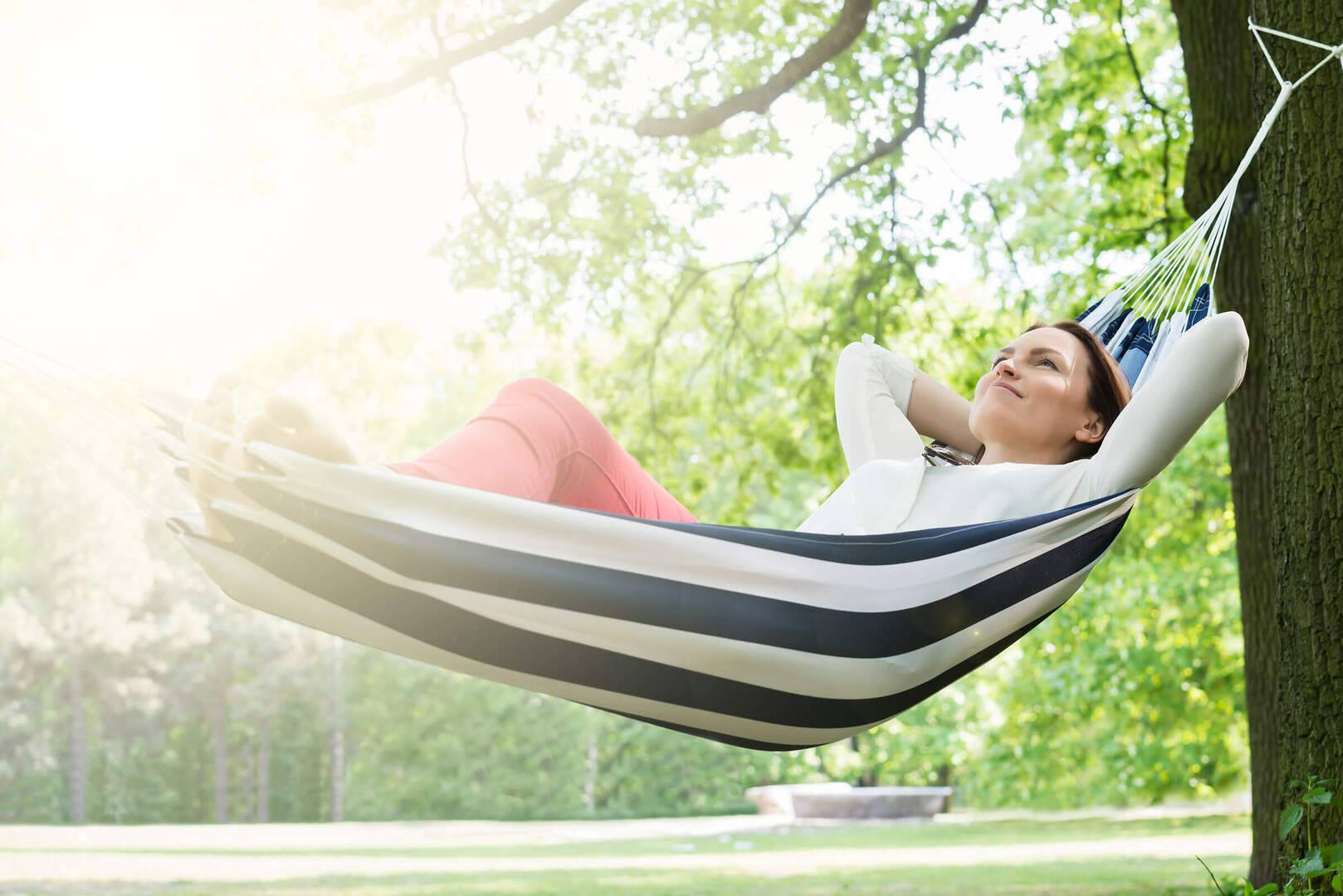Hanging out in Iowa: Hammock Camping in the Hawkeye State

Hanging out in Iowa: Hammock Camping in the Hawkeye State
By Rod and Laura Woten
It doesn’t seem to matter where we camp, our hammock setup always seems to be the talk of the campground. If we had a nickel for every person that stops by and asks to check out the hammocks that Laura and I camp in, we’d be well on my way to financial independence! While we’ve only been hardcore hammock campers for a couple of years now, we are both committed to the mantra of, “I’ll never sleep on the ground again!” We are hearing the same thing from other hammock campers. To someone that doesn’t hammock camp it may sound impossible. “How do you stay warm?” we get asked by other campers? Or, “How do you stay dry?” Or, “How is that even comfortable?”
Lightweight AND Comfort
It’s amazing to me how something as compact and lightweight as today’s camping hammocks can support as much weight as they do. Our Kammok Mantis camping hammocks along with the rain fly, stakes and suspension straps can stuff into a sack about the size of a cantaloupe yet support up to 400 pounds! There are also oversized options out there for those that need something longer, wider or with a higher weight capacity as well as ultralight versions with less capacity that pack much smaller and lighter for those that need lighter or smaller systems like backpackers, bicycle tourists, etc.
To many non-hammockers, the curvature that they associate with lounging in a hammock seems like it would be very uncomfortable. While this type of curve is still possible even with the best hammocks available today, hanging the hammock properly will help to lessen this. The first thing is to ensure that the head end is slightly lower than the foot end of the hammock. This keeps you from sliding towards the foot end of the hammock, which would put your back, shoulders and neck in the most curved part of the hammock. Another essential is to ensure that angle of the suspension from the trees to your hammock is about 30 degrees. Any greater and the curve is greatly exaggerated, any less and the tension in the suspension and hammock is too high. Not only does this create an uncomfortable ridge of fabric right down the middle of the hammock, but it also puts you at risk of a suspension or hammock failure that painfully dumps you right on the ground.
One final trick to ensure a comfortable night’s sleep in your hammock is to sleep at a slight angle to the centerline of the hammock; your torso on one side or the other of the centerline and your hips and legs on the other. This effectively places your body across the flattest portion of the hammock and creates a flat hang. You will probably hear many hammockers refer to themselves as a right or left sleeper. What they are referring to here is the side of the centerline that their head and shoulders are on once they are properly positioned in the hammock. Typically, this angle is about 30 degrees from center, but you will need to experiment with your setup to determine exactly what angle allows for the flattest lay possible.
Another component of comfort is keeping the bugs at bay. This is especially important in Iowa where it seems like we have biting insects in the air almost 10 months out of the year. It’s really hard to get a good night’s sleep when you are the mosquito menu for the evening. To that end, most good camping hammocks will either have a bug net integrated into the hammock, like my Kammok Mantis, or have one available that you can hang your hammock inside of when you set it up. Most bug nets are either side entry, where you enter through a zipper in the side as you climb into your hammock or bottom entry where you lift the bottom of the bug net over your head to get inside the net before you climb into your hammock. I prefer an integrated bug net or the side zip but give each a try to see which you prefer. Regardless of what style you choose, if you plan to do any hammock camping in Iowa, a good bug net for your hammock is a necessity!
Staying Warm and Dry
One of the great things about a hammock is that you have no fabric over your head to obscure your view of the night sky. Imagine falling asleep as the Milky Way galaxy unfolds right before your eyes! On rainy days, one of the not-so-great things about a hammock is that you have no fabric over your head to shield you from the rain. For this reason, hammock campers also include a rain tarp as part of their hammock setup. This could be a simple camping tarp rigged between trees directly over your hammock or a tarp with a hammock-specific cut that allows for ample coverage while still allowing decent views of the surroundings from the hammock. This special cut also helps to save weight and bulk when packed. Many hammock specific tarps can also be quarter-pitched, half-pitched or stowed in “tarp snakes” above the hammock as to not interfere with viewing the night sky when it isn’t raining and deploying quickly if it starts to rain.
One of the best things about hammock camping is that it gets you up and off of the cold, hard, damp ground. While this is a great thing, it also exposes your backside to moving air. Even when the air temperature is 60 degrees outside, it’s amazing how the slightest breeze across your back in a hammock can make it seem much colder. For this reason, there are special insulation considerations needed when camping in a hammock. Probably the most effective method is to use an under-quilt. An under-quilt is exactly what it sounds like…a quilt that goes under your hammock. It hangs under the hammock so that your weight does not compress the loft of the quilt, giving you the most warmth. Laying directly on top of it would compress the loft and you eliminate most all of the insulation. This same concept applies to tent-camping as well and is the best reason to use a sleeping pad. Most under-quilts are goose down, but there are good synthetic options available as well. Unlike a standard trail quilt, under-quilts have some sort of suspension built in, usually shock cords sewn into each side hem and tied together in a loop at each end, to allow you to fasten it to your hammock suspension and wrap it around the body of the hammock. There are even some under-quilts in the market that can be converted into rectangular sleeping bags or a trail quilt to be used on the top of you when sleeping.
Under-quilts can be expensive, especially down under-quilts. For this reason, many hammock campers prefer to use an insulated sleeping pad just like the one used when camping in a tent. This a decent solution, but the issue with using an insulated mat is that, unlike in a tent, your “bed” wraps around your sides in a hammock. The under-quilt provides insulation in these areas as it wraps around as well, but most pads do not, especially if the pad is a 20” wide backpacking mat. There are a few air pads available that have additional “wings” on the side to offset this issue and there are even sets of wings that you can add to an existing air mattress to provide insulation along the sides. Sometimes, when it’s REALLY cold out, I like to use a sleeping pad along with an under-quilt to improve the comfort rating and ensure a toasty night’s sleep.
You will also need insulation on the top side to ensure a warm comfortable night’s rest. A sleeping bag can cover this need fairly well, but you will probably want to zip it open and sleep under it, rather than in it. There are a couple of reason for this. The first reason is that a sleeping bag is very difficult to wriggle into in a hammock. The second reason, as mentioned previously is that all the insulation that you lay on in the back side of the sleeping bag gets compressed under your weight which reduces the loft and almost completely eliminates any insulation underneath you. That’s why it’s so important to use a good sleeping pad in a tent or under-quilt in a hammock.
One final cold weather consideration for hammock camping is a “winter sock” or cold weather barrier. This is simply a solid piece of fabric that surrounds your hammock or in the case of my Kammok Mantis it replaces the bug net and zips over the top of the hammock. These barriers help to seal out wind and hold in heat and can make a big difference in the amount of heat retained in cold weather. You’ve essentially turned your hammock into a cozy, suspended tent!
No Trees
One of my favorite questions we get from non-hammockers is, “What do you do if there aren’t any trees?” This is one of my favorite questions because it means I get to tell them all about hammock stands! Ironically enough, way more than half of our camping is done in areas where there aren’t enough trees for hammock camping, the trees are spaced too far apart for hammock or park rules prohibit hanging anything, including hammocks, from trees. It is specifically for these reasons that we built portable hammock stands for our hammock. The style that we built are often called a “Turtle-Dog” stand, which is a reference to the screen name for the hammock forum member that originated the design. While the stands are portable, they are definitely not something you would want to take on a backpacking, bicycle touring or canoe trip. They fit perfectly in the bed of my truck, and are ideal for much of the car-camping we do. There are several variations of the Turtle Dog on the internet, as well as a few other designs, so a simple search will turn up lots of options. There are also a few good options out there for purchase from some of the companies making hammock gear.
In this same vein, it’s very important to know the regulations for wherever you intend to hammock camp. As I mentioned before, some places don’t want anything hanging from trees, some require a 2” or wider tree strap and others have no rules whatsoever around hammocks, so make sure you know before you go. It’s also a good idea to invest in a pair of tree-savers. These are simply wider pieces of webbing that go around the tree and then your suspension is fastened to the tree saver. Some suspensions are so thin that they cut into the tree and damage the bark if wrapped around the tree directly. Some suspension systems, like the Python Straps that I use from Kammok are wide enough that the tree saver is already built into the strap, so pay attention when you select your suspension to determine if you need to invest in tree savers as well.
If you are looking for a different, more adventurous type of camping, we highly recommend giving hammock camping a go. There will definitely be some trial and errors as you get used to this new style, but we promise once you get accustom to the new gear you will never go back to sleeping in a tent! Good luck with your new adventures into hammock camping!


